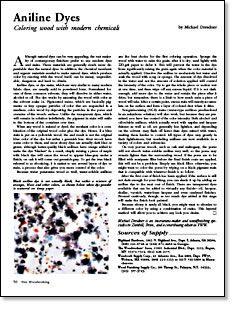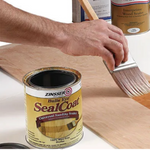
Synopsis: Michael Dresdner explains how aniline dyes work and how to apply them effectively. He offers tips such as how to predict how the color will turn out – blue stain on yellow wood will produce a greenish hue. Simply staining a piece of maple with black dye will cause the wood to appear blue-gray; oak will come out greenish-gray. He explains how to get a truer black and how to control the color better. Water-soluble dyes are the best choice for the first coloring, and Dresdner offers tips on staining open-pored woods.
Although natural dyes can be very appealing, the vast majority of contemporary finishers prefer to use modern dyes and stains. These materials are generally much more dependable than the natural dyes. In addition, the chemical mordants and organic materials needed to make natural dyes, which produce color by reacting with the wood itself, can be messy, unpredictable, dangerous and hard to obtain.
Aniline dyes, or dye stains, which are very similar to many modern fabric dyes, are usually sold in powdered form. Formulated for one of three common solvents, they will dissolve in either water, alcohol or oil. The dye works by saturating the wood with color as the solvent soaks in. Pigmented stains, which are basically pigments or tiny opaque particles of color that are suspended in a medium, color wood by depositing the particles in the pores and crannies of the wood’s surface. Unlike the transparent dyes, which will remain in solution indefinitely, the pigment in stain will settle to the bottom of the container over time.
When any wood is stained or dyed, the resultant color is a combination of the original wood color plus the dye. Hence, if a blue stain is put on a yellowish wood, the end result is not the original blue color of the dye but rather a greenish hue. Most woods have some color to them, and most ebony dyes are actually dark blue or green, although better-quality black anilines have orange added to make the dye “blacker.” As a result, simply staining a piece of maple with black dye will cause the wood to appear blue-gray under a finish; on oak it will come out greenish-gray. To get the true black referred to as ebonizing, it is easiest to use several layers of dye or stain, a process that also gives you more control of the color.
From Fine Woodworking #76
For the full article, download the PDF below:
Fine Woodworking Recommended Products

Osmo Polyx-Oil

Foam Brushes























Log in or create an account to post a comment.
Sign up Log in